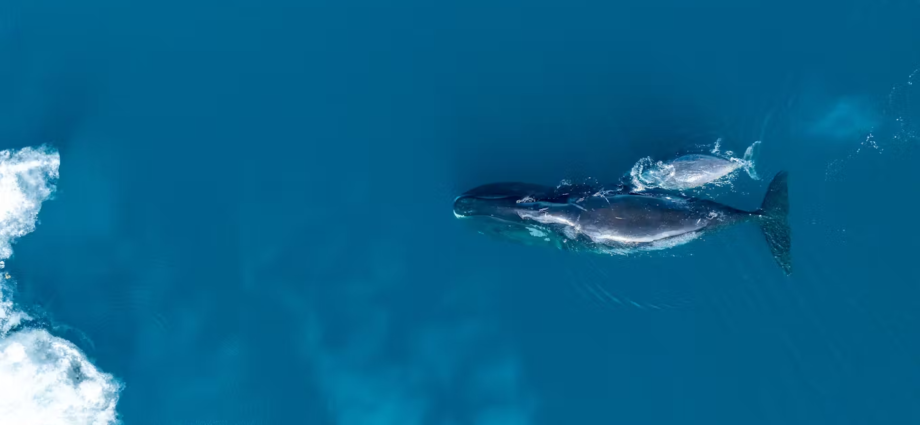
Matt J. Thorstensen, University of Manitoba
October 30, 2024
Bowhead whales are the longest-lived mammals on Earth with some able to live hundreds of years. What’s more, Inuit hunters have observed these whales breaking ice over half a metre thick – ice strong enough to support a fully-loaded semi truck.
The living ranges of the narwhal whales overlap with those of the bowheads in the Arctic. Narwhals were central to northern European mythology about the legendary unicorn due to their distinctive tusk.
However, despite their iconic status in the eyes of many, both of these magnificent creatures have faced centuries of violent persecution by human commercial whalers. Bowhead whales, in particular, were prized for their blubber, oil, bones and filter feeding system from 1540 until the 20th century — a period lasting nearly 400 years.
A reminder of this exploitation was found in 2007, when a bowhead whale in Alaska was found to have fragments of a harpoon lodged in its body. This relic of Massachusetts-based whalers, originally hurled in the late 1800s, is representative of the long-lasting impacts of commercial whaling on individual animals and their populations.
As these species recover from the effects of commercial whaling, they now face a new challenge: climate change. The Arctic is warming almost four times faster than the global average, causing profound changes to the region’s ecosystem. Species that have adapted to life in these extreme conditions, such as polar bears, Arctic seabirds and Arctic fish, must all now adjust to climate change or perish.
Adapt or die
One way organisms can adjust to climate change is through adaptation. Adaptation is a concept with a long history in biology and one central theme: organisms must match their environments, often through evolution.
Adaptation depends in large part on the genetic variation present in a population, as variation provides the raw material for evolutionary change. However, if you remove large numbers of individuals from a population whether by hunting, habitat loss or other factors, then you remove genetic variation. In this way, hunting and habitat loss directly impede species adaptation.
Has commercial whaling affected genetic variation in Arctic whales? That was the question we set out to answer for both bowhead whales and narwhals. Our goal was to understand how the historic exploitation of these two species may influence their ability to respond to climate change in the future.
This work was a collaborative effort. Our team at the University of Manitoba worked with Inuit subsistence hunters, researchers at the Assiniboine Park Zoo and Fisheries and Oceans Canada. Together, we sought to unravel the genetic legacy left by centuries of commercial whaling and its implications for the resilience of these iconic Arctic species.
Striking impacts
Focusing on whales in the eastern Canadian Arctic, we looked for changes in effective population size — the number of individuals that contribute to a population — across thousands of generations for each species. The results were immediately striking.
We observed a sharp decline in effective population size in bowhead whales concurrent with commercial whaling, a clear indication of the impact this industry had on their genetic diversity. Narwhals, by contrast, did not exhibit a similar decline.
These patterns are consistent with historical records showing that commercial whalers primarily targeted bowhead whales. Surprisingly, narwhals in our study had much less genetic variation than bowhead whales. We thought bowhead whales, having endured more intensive exploitation, would have lower genetic diversity in the present day than narwhals, if both species began with similar levels of variation.
It turns out that each species did not start at similar levels of genetic variation.
Approximately 2.5 million years ago, both species exhibited a decline in effective population size, which was more pronounced in the narwhal. It is possible that this decline was instigated by an ice age that may have been caused by a “nearby” supernova explosion that damaged the Earth’s ozone layer.
Regardless of cause, our study shows that narwhals in our study area have much less genetic variation than bowheads in the present day.
An uncertain outlook
What does this mean for adaptations to climate change? Unfortunately, the prognosis is worrying.
Narwhals have less genetic variation to work with, but bowhead whales are not doing great, either. Commercial whaling has decreased the effective population size of bowhead whales by more than tenfold, putting them at risk of further declines of genetic variation in the future. Despite recovering in numbers, bowhead whales may be plateauing far below pre-whaling estimates.
Urgent conservation action may preserve the remaining genetic variation, allowing bowhead whales to partially recover and hopefully endure the worst impacts of climate change. Although Canadian Arctic narwhals may not be at imminent risk from their low genetic variation, they will still require conservation attention due to their limited capacity to adapt to changing environments.
It takes far longer to build up genetic variation than it takes to lose it. Just as a harpoon thrown in the 1800s was found embedded in one bowhead whale in 2007, the legacy of past commercial whaling profoundly shapes the genetics of bowhead whale populations in the present. This history will continue to depress genetic variation for millennia, posing a long-term challenge for the conservation of this species.
Fortunately, both narwhals and bowhead whales are subject to federal protections in Canada. At the same time, intense commercial whaling has largely ceased. That being said, the effects of climate change are accelerating, especially in the Arctic.
The bowhead whale and narwhal demonstrate how past events, human actions, present challenges and future threats intersect to shape Arctic biodiversity. The lessons we learned about connecting the past to the present in the narwhal and bowhead can, and should, help inform efforts to protect the biodiversity of all species as they try and adapt to a changing climate.
Matt J. Thorstensen, Postdoctoral Fellow, Department of Biological Sciences, University of Manitoba
Subscribe to our newsletter.
This article is republished from The Conversation under a Creative Commons license. Read the original article.

